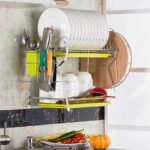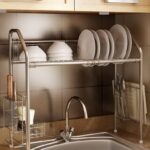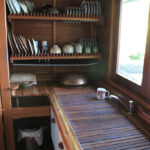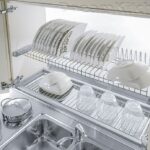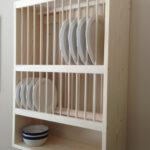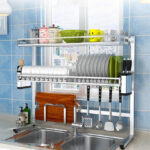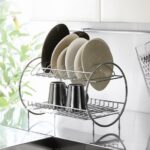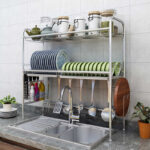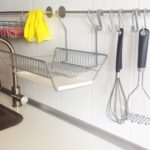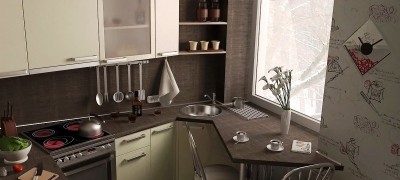Kitchen dryer for dishes in the cupboard
In modern homes with small kitchens, you have to take into account every centimeter of area and space, while you want to keep the zest of the interior design, make it modern and harmonious. Various designs have been invented for storing wet mugs, plates, serving dishes of various formats, tea porcelain, glass.

The dish drainer can be hidden in the closet or fixed directly on the wall, table, sink. It all depends on the shape and features of the models. There is a similar element for any kitchen. Manufacturers offer all kinds of modifications. There are designs that combine the function of drying and storage systems for table setting.

Why do you need a dish dryer
Dry the dishes well after washing. To do this, you can lay it out on a table or tray, a corrugated surface near the sink. Some housewives prefer to immediately wipe the table faience, porcelain, glass and metal, and put them on cabinets and shelves.

Of course, all options have a right to exist. But the best way to store utensils is to dry the dishes in the closet. When the surfaces dry naturally, there is no lint left on them from the fabric, no effort is needed to remove the water. Many people use drying modules as a storage system, do not shift porcelain and glass to the shelves. The ribbed plate is easy to remove. Finding the desired item in the stack is much more difficult.
For reference. People invented dish dryers at the dawn of civilization. With the development of the technical industry, designs are constantly being improved. Modern models are made of lightweight, durable materials that are harmless to the body.
Varieties of designs
Dish dryers differ not only in size, number of tiers, type of materials used. There are options with and without fastening, not all of them have a lower drain pan. Some housewives prefer to install structures so that the water flows directly into the sink or open modifications that do not need to be built into the cabinet.

The main types of dryers:
- single-tiered, designed for plates only;
- bunk with an upper section for tea utensils;
- specialized for drying and storing all serving items, including cutlery.
Important. When choosing a model, the composition of the family, the lifestyle of the inhabitants of an apartment or house, and the interior are taken into account. In stores, on Internet resources, you can find dryers of various price categories, designs for direct furniture modules and corner sections.
Troflexes
Such drying is simple and accessible, it is a folding grid or a perforated panel. Designed for everyday use of a small family, installed on a sink.After use, troflex is put into a drawer until the next washing of dishware sets.

The model is universal, it is convenient to lay out washed fruits, vegetables, herbs on a grid or panel. The subject does not need to be selected for the interior, think over the location. Troflexes are made of impact-resistant plastic, soft polymer of stainless steel or chrome-plated iron.

Tabletop
When it is difficult to allocate space for a dish drainer in a cupboard or on a wall, you should find an option that is installed on a horizontal plane. For drying, you can attach a separate shelf at the sink or place the module on the table. They produce volumetric combined systems and small plastic modules of various colors.

You can choose an option to match the walls or curtains, then the device for laying raw cutlery will turn into an additional decor. Noteworthy are folding or sliding transformers, which take up a minimum of space during storage. For a small kitchen, such models are not entirely convenient - they clutter up the space, do not protect the dishes from dust and grease, and accidental drops from the sink. Some housewives install similar plastic options in cabinets, away from water and eyes.

Wall mounted
Open modifications of dryers are hung at the work table on an apron made of tiles or other easily washable materials. If desired and necessary, a lightweight but durable aluminum structure can be mounted directly on the wall in any free space or installed inside the headset near the sink.

This is a compact version of the cutlery storage system in one place. Wall-mounted models are an alternative to desktop models that clutter up your desk. The main disadvantage of open options is that there is no protection against contamination. In the kitchen, the sink area is a source of germs from raw meat, poultry, fish, unwashed vegetables. When washing with splashes, microorganisms scatter in all directions and can get onto clean dishes.

When frying oil, fats evaporate from the pan. Over time, dense deposits appear on the frame, which are poorly cleaned in hard-to-reach places.
Note! In addition to dishes, all kinds of utensils are stored in the dryer: graters, funnels, strainers. For convenience, make additional suspensions or hooks made of soft wire.
Embedded
Frames hidden in furniture are the most common. To attach the dish drainer to the cabinet, use standard threaded fasteners and frames. Ready-made modules in headsets are placed above the sink and on the lower tier. Built-in frames are made in the form of tiers of typical wall dryers, fixed on the frame, or in the form of baskets.

Benefits of a built-in dish drainer
When beautiful fronts are installed in the kitchen, the choice is obvious: you need a built-in model to store washed cutlery sets. The closed modules are protected from dust, hot fat molecules flying in the air. In such a dryer, it is possible to store plates, glasses and mugs for permanent use. You will not need to provide additional space in the wall or drawers for storing serving items.
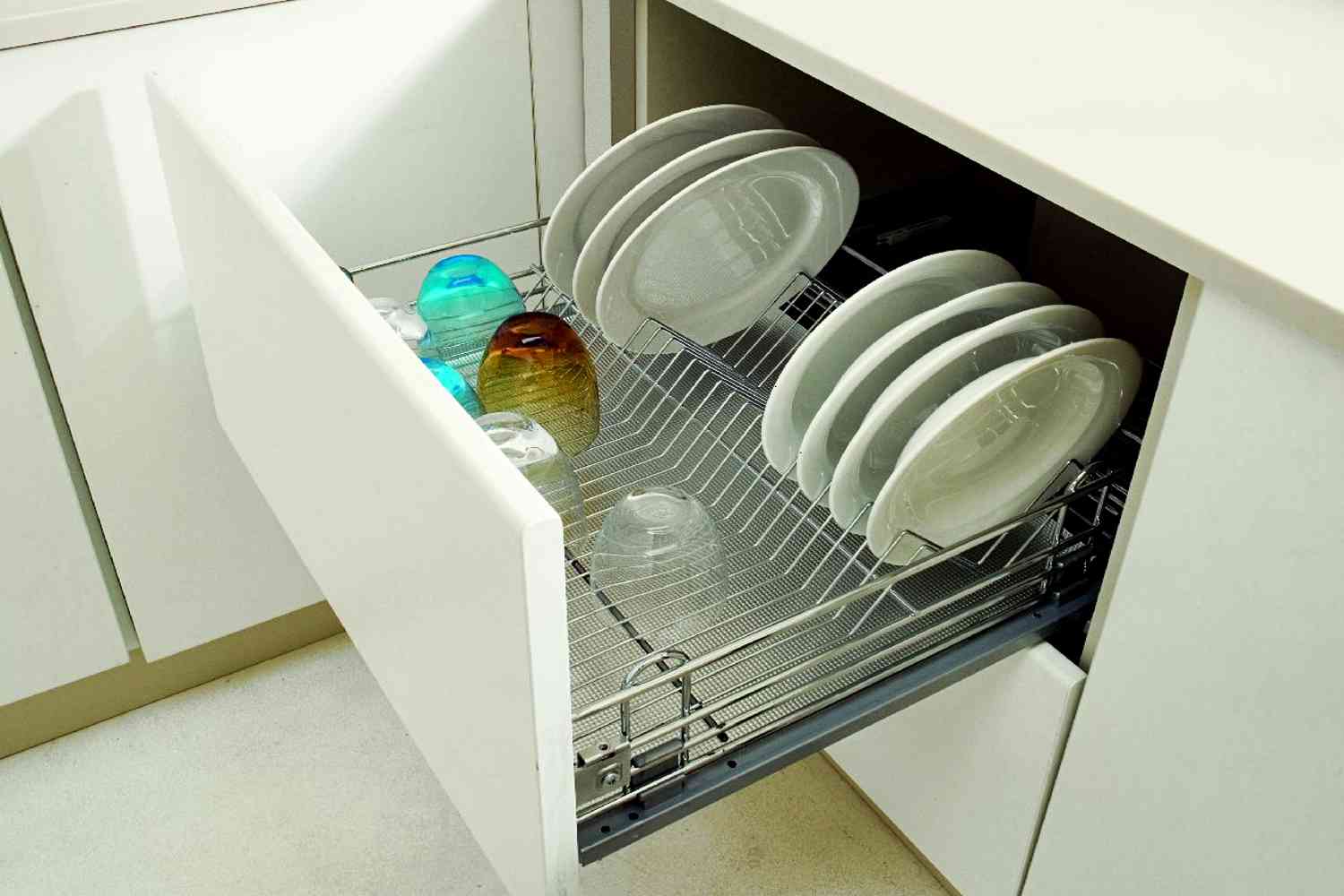
For a small volume of dishes, three or four serving sets, a double dish drainer is convenient. With a large volume of plates, modular is preferable.
These are not all the benefits of built-in modifications, there are others:
- the harmony of the kitchen space is not disturbed;
- the surface of objects remains clean during long-term storage;
- the risk of accidental dropping of dishes when moving the inhabitants around the kitchen is eliminated.

Important! Built-in models are placed at eye level or below. Convenient when the dryer is next to the dishwasher, it is used for compact storage and storage of dishes.
What are the requirements for dryers
Any kitchen utensils must be kept clean, the health status of the inhabitants of the dwelling depends on this. A kitchen dryer for dishes in a cupboard must comply with environmental safety requirements, for the purpose of constructing designs are used:
- polymers free of phenols and formaldehydes;
- food-grade metal that does not form soluble harmful oxides;
- wood treated with harmless paints and varnishes.

There are several unshakable rules for choosing and installing dish dryers:
- It is necessary to exclude the conditions for the development of pathogenic organisms:
- focal damage and rust are not allowed on the surface;
- the structure should be easy to clean, resistant to contact with detergents, disinfectant solutions;
- the pallet located at the bottom must be mobile, it is regularly processed;
- provide good ventilation for regular air exchange.
- The frame holding plates, mugs, cups is designed for a certain load. Usually, manufacturers provide a large margin of safety to avoid breakage of the dishes when overloaded.
- It is important to preserve the aesthetics of the design of the space, it is nice when all kinds of adaptations harmoniously fit into the interior. Drying is mounted inside furniture or selected for textiles, wall decoration.
DIY installation
Dish drying, depending on the type of construction, is set:
- in the frame;
- on suspensions;
- is placed on a frame module without a bottom, when a spontaneous flow of water into the sink is provided.
Much depends on the length and reliability of the hardware. Filled meshes and nets weigh a lot, especially if the dishes are made of earthenware or ceramics. Fasteners are selected according to the type of cabinet wall. For solid bases, a dowel is needed, for wood and slabs, self-tapping screws are enough.

Note! The screw head is installed with a protrusion above the wall surface up to 5 mm, the length must exceed the wall thickness up to 7 mm.
Sequence of operations:
- the main dimensions of the drying are measured: length, height;
- markings are applied to the inner surfaces of the cabinet, when two tiers are installed, up to 30 cm is left between them;
- self-tapping screws are cut with a screwdriver or screwdriver;
- parts of the structure or the whole are installed.
The operation does not take much time, you will be able to install the dish dryer yourself. When the upper and lower rows are separately mounted in different places of the kitchen set, they adhere to the same technology. When using models as storage systems, in addition to depth and width, the height of the box is taken into account.

Note! When marking, take into account the size of plates, dishes, salad bowls.It is necessary to indent from the back wall, doors, so that the distance from the axial lower part of the dryer exceeds the radius of the largest dishes.
How to do without drying
Some housewives prefer not to install dryers, let the dishes drain or wipe them with a towel, and then put them in stacks in the closet. Manufacturers offer special stand-holders of various diameters, it is convenient to remove the entire stack at once. Dishwasher owners disassemble dry, clean dishes. There is no need to put the utensils into drying.

Video: types of dish dryers in the kitchen
